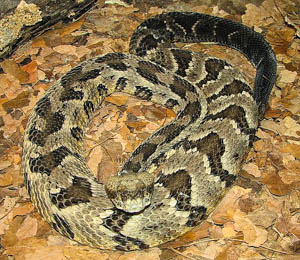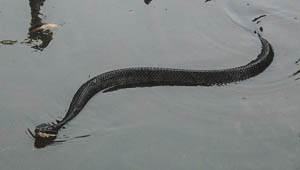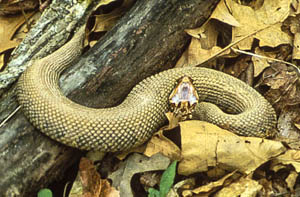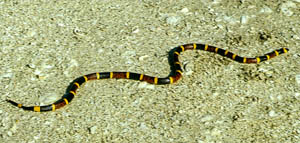Snake bites First Aid
The signs of, and treament for, Snake bites
The vast majority of snake bites are not venemous. They may hurt, but they are not going to kill you.
Also, no snake actually wants to bite you. You are way, way too big to eat. They will only attack to defend themselves if provoked, surprised, or disturbed. So avoid doing that.
Venemous snakes in the US
There are only four common venemous snakes in North America, and only three in our area and the regions we usually hike in (the mid-Atlantic and Northeast U.S.).
Eastern RattlesnakeEveryone on the Black Forest Trail summer hike is intimately familiar with these. Also called Timber Rattlesnakes, they can grow up to 3–4 feet long on average, and have the longest fangs and most powerful venom of any North American snake. Luckily, they have that built-in rattle warning stystem, so you usually hear them before you see them—and they do a lot of rattleing and feint-attacking at you before they will acually bite, so they are among the easiest to avoid/run from. Our Eastern rattlers are generally thicker and darker than the classic Western Rattler you see in movies. They can very greatly, but tend to have that classic, wedge-shaped head, yellowish or grey scales interrupted by bands of dark scales that undulate thick and thin (some come in rounded butterfly-like blobs); these darker bands or blobs are often "outlined" by lighter scales. The ones in PA seem often to have black tails. Also, there's a rattle at the end of the tail. But you knew that. |
 |
CopperheadThese scare me the most, since their skin—mottled browns, tans, blacks, and reddish-browns—blends in so well with fallen leaves. (This is on purpose, since that is where these abush predators to ambush mice small rodents.) Also, I once almost stepped on one, coiled amid those camouflaging leaves, in the middle of a trail on a scout trip. It wasn't even deep in the woods; it was at the trailhead along the Tohickon Creek right by the parking lot in Point Pleasant, Bucks Country whre we go all the time for our patented water crossing/rock climbing daytrips. That said, the copperhead's venom is among the weakest of our local scary snakes, and they usually give a non-venemous warning bite first if distrubed. |
 |
Water Moccasin / CottommouthTwo names for the same snake—the first giving you a hint to its habitat (around water), the second to its appearence: When threatened, it vibrates the tip of its tail, rears its head, opens its dazziling white mouth, and hisses. (This is your signal to run away.) It is a pit viper, like its copperhead cousin, and ranges across the entire southeastern quadrant of the U.S., from Virginia to Florida and southern Illinois/Indiana to Texas. (I had a scary encounter with one while river tubing in the Great Smoky Mountains of Tennessee). Cottonmouths are pretty huge—anywhere from 2.5 to over 6 feet long, and thickbodied—and can swim, which is doubly terrifying. They have a mottled skin, but it is usually of dark-on-black, so they kind of appear mostly black (like the one on the right swimming), though some are done in light, sandy tans and browns (like the one on the right demonstraing the threat display). |
  |
Coral snakeThis one is mostly found in the American Southeast (the Carolinas to Florida to Louisiana), Texas, and Arizona (those in Texas/Arkansas and in Arizona are actually of two other, related species, but they all look pretty similar). However, since we do often travel to all those areas... A New World coral snake has very distinct striped pattern: Wide band of red, thin band of yellow, wide band of black, thin band of yellow; repeat. The yellow is sometimes more of a yellow-orange. There are other, mimic snakes with similar banding, but—this is key—they do not have yellow touching red. (Kingsnakes have wide red, then narrow black-yellow-black; Scarlet snakes substitute white for yellow.) Then again, you don't want any kind of snake to bite you, so avoid them all. |
 |
How to avoid snake bite
- Do not annoy a snake. That should go without saying, except I know most of you. Two-thirds of all snake bites happen to people who intentionally provoked the snake. Don't be those idiots. Admire the snake from afar, take a photo (preferably with a nice zoom lens), then make some noise to scare it off or skirt around it, giving it a wide berth.
- Most snakes would much rather slither away than bite you. Give them every opportunity to do so.
- Wear high-cut hiking boots. The thick leather or other material will help protect your ankles.
- Stay on the trail. Snakes do like to sun themselves on trails, but at least you will be able to see them—which is not the case if you are hiking through grasses or ferns.
- Make noise while hiking. This is not usually a problem for this troop. Ha ha. But really, what you want to do it create ground vibrations, which snakes are very keen on picking up. The stomping of a dozen pairs of boots is usually quite enough in the vibrations department, but in snake country its wise to carry a staff or waking sticks and thump the ground with them, too.
- Watch where you put your feet. Especially stepping over logs and big rocks. In fact, step ON rocks and logs, not over them. Bang any unseen area where you are about to place your foot with the staff or stick first to scare any potential snakes (or, at worst, so that he will bite the staff instead.)
- Watch where you put your hands. When climbing or scrambling, know that snakes often sun themselves on rock ledges or boulders, so be careful when reaching up for that handhold—especially if the handhold starts slithering.
- Do not lift big rocks. Snakes like to sleep under there. Also, under Leave No Trace you should not be moving rocks anyway unless it is to build a fire ring.
- Snakes are more active at dawn and dusk and at night. Then again, that's just a general rule. I've run into rattlers at high noon.
- Snakes hibernate. Another reason to enjoy winter hiking.
- Be careful lifting your backpack up after a packs-off break. (Many moons ago, on a trip out west, we had to wait about half an hour for the western rattlesnake snoozing in Renzi's pack to decide to leave—though, after a while, we had to encourage it by throwing rocks.)
Signs of snake bite
- A snake jumps out and bites you. You generally tend to notice this.
- Fang marks. Twin puncture wounds indicate you were bitten by a fanged snake, which means it was a venmous snake.
- If the area around the bite starts to swell and/or discolor, or causes more pain than a simple small puncture wound would seem to entail, it was likely a venemous bite. Please do not panic.
How to treat snake bites
First the don'ts. There are many myths or ancient, disproven techniques about how to treat snakebites, so let us dispense with those right way.
- DO NOT suck out the venom. This old, wrong technique has unfortunately been made famous by countless old Westerns and other movies. If you try it, you are not actually going to remove the venom already in the bloodstream; you're just going to infect the wound site.
- DO NOT apply a torniquet. There idea there was to stop the flow of infected blood above the bite site; that blood is already moving though the body. All a torniquet is going to do is potentially cause you to lose the arm or leg.
- DO NOT apply ice or a cold pack. It will only slow down the arrival of good blood to the site.
- DO NOT carry a so-called "snake bite kit." They only allow you to perform some of the idiotic faux "treatments" above. (I carried one as a kid, but we were stupider back then.)
- DO NOT drink caffeine or alcohol; it will only speed the venom though your body.
- Above all, REMAIN CALM. The calmer you are and more slowly you move, the more slowly your heart will beat and the more slowly the venom will work its way through your system.
- Move away from the snake—far enough that it can no longer bite you. 20-30 feet is good.
- If you even suspect it might have been a venomous snake that bit you, call 911 immediately. The only true treatment for snake venom is antivenin, and only medical authorities and emergency responders have that.
- Memorize what the snake looks like. (For God's sake, don't try to catch it. Take a picture or memorize iis markings so you can tell the medical responders and they can identify it and provide the appropriate antivenin.)
- Remove any tight clothing or jewerly from the affected limb; the area around the bite might swell dramatically (particularly with rattlenake bites).
- Try to position your body so that the bite is below the level of your heart—which means do not lie down flat, Sit, or recline a steep angle if you must.
- Mark the outer edges of any swelling/discoloration with a pen every 15 minutes so doctors can later determine the rate of spread. Also keep track of any other symptoms and when they occur (dizzyness, funny taste in your mouth, etc.)
- If you are 100% positive it was a non-venemos snake, just treat the little twin puncture wounds like you would any other (clean, disinfect, bandage)—but just in case, stay still for a good long time and keep an eye on it for swelling , pain, or discoloration that might indicate venom.
- Clean the wound—though do not try to flush it—and cover it with a dry bandage.
- Try to relax and wait for help to arrive. This is, admittedly, not easy when you think you have been bitten by a venemous snake. But try. Do deep breathing exercises. Think happy thoughts. remaining calm and still is the best way to survive.
- If you are in the backcountry, out of cellphone range, and cannot reach 911, carry out the victim, if possible. If not possible to carry him or her, have the victim walk slowly while you carry their pack and gear. As soon as you get a phone signal, call 911 and do whatever they say (which will usually be "stay there and we'll come get you").
- Know this: Even when you are bitten by a venemous snake, many times it is a "dry bite"—one where they do not actually pump any poison into you. Bites are fully dry about 20% of the time—and in many other cases, the snake will release only a small amount of venom. This is all good news. This does not mean you should not take every precaution above, just that panicking is one of the worst things for snakebite, so I am trying to allay some of that fear.
Related pages
- Wilderness first aid
- Other kkills
- The 10 essentials
- The 7 survival priorities
- Leave No Trace principals
- Packing lists
- Useful links (including where to get gear)
- Troop calendar (upcoming trips)
- The trips program
